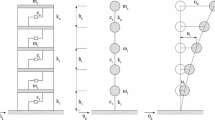Abstract
The present paper takes from the original output-only identification approach named Full Dynamic Compound Inverse Method (FDCIM), recently published on this journal by the authors, and proposes an innovative, much enhanced version, in the description of more general forms of structural damping, including for classically adopted Rayleigh damping. This has led to an extended FDCIM formulation, which offers superior performance, on all the targeted identification parameters, namely: modal properties, Rayleigh damping coefficients, structural features at the element-level and input seismic excitation time history. Synthetic earthquake-induced structural response signals are adopted as input channels for the FDCIM approach, towards comparison and validation. The identification algorithm is run first on a benchmark 3-storey shear-type frame, and then on a realistic 10-storey frame, also by considering noise added to the response signals. Consistency of the identification results is demonstrated, with definite superiority of this latter FDCIM proposal.













Similar content being viewed by others
References
Chen J, Li J, Xu YL (2002) Simultaneous estimation of structural parameter and earthquake excitation from measured structural response. In: Proceedings of the International Conference on Advances and New Challenges in Earthquake Engineering Research (ICANCEER 2002), vol 3, pp 537–544, 15–20 Aug 2002, Hong Kong, China
Chen J, Li J (2004) Simultaneous identification of structural parameters and input time history from output-only measurements. Comput Mech 33(5):365–374
Concha A, Icaza LA, Garrido R (2016) Simultaneous parameters and state estimation of shear buildings. Mech Syst Signal Process 70:788–810
Ghahari S, Abazarsa F, Ghannad M, Taciroglu E (2013) Response-only modal identification of structures using strong motion data. Earthq Eng Struct Dyn 42(11):1221–1242
Haldar A, Ling X, Wang D (1997) Nondestructive identification of existing structures with unknown input and limited observations. In: Proceedings of the 7th International Conference on Structural Safety and Reliability (ICCOSAR 97), vol 1, pp 363–370, 24–28 Nov 1997, Kyoto, Japan
Li J, Chen J (1997) Inversion of ground motion with unknown structural parameters. Earthq Eng Eng Vib 17(3):27–35 (in Chinese)
Li J, Chen J (2000) Structural parameters identification with unknown input. In: Proceedings of 8th International Conference on Computing in Civil and Building Engineering (ICCCBE-VIII), vol 1, pp 287–293, 14–16 Aug 2000, Stanford, California
Li J, Chen J (2003) A statistical average algorithm for the dynamic compound inverse problem. Comput Mech 30(2):88–95
Ling X, Haldar A (2004) Element level system identification with unknown input with Rayleigh damping. J Eng Mech ASCE 130(8):877–885
Mahmoudabadi M, Ghafory-Ashtiany M, Hosseini M (2007) Identification of modal parameters of non-classically damped linear structures under multi-component earthquake loading. Earthq Eng Struct Dyn 36(6):765–782
Pioldi F, Ferrari R, Rizzi E (2015) Output-only modal dynamic identification of frames by a refined FDD algorithm at seismic input and high damping. Mech Syst Signal Process 68–69:265–291. doi:10.1016/j.ymssp.2015.07.004
Pioldi F, Ferrari R, Rizzi E (2015) Earthquake structural modal estimates of multi-storey frames by a refined FDD algorithm. J Vib Control. doi:10.1177/1077546315608557, available online
Pioldi F, Ferrari R, Rizzi E (2016) Seismic FDD modal identification and monitoring of building properties from real strong-motion structural response signals. Struct Control Health Monit. doi:10.1002/stc.1982
Pioldi F, Rizzi E (2015) A refined Frequency Domain Decomposition tool for structural modal monitoring in earthquake engineering. Earthq Eng Eng Vib (in press)
Pioldi F, Rizzi E (2016) A Full Dynamic Compound Inverse Method for output-only element-level system identification and input estimation from earthquake response signals. Comput Mech 58:307–327. doi:10.1007/s00466-016-1292-0
Pridham B, Wilson J (2004) Identification of base-excited structures using output-only parameter estimation. Earthq Eng Struct Dyn 33(1):133–155
Toki K, Sato T, Kiyono J (1989) Identification of structural parameters and input ground motion from response time histories. In: Proceedings of the Japan Society of civil Engineers - Structural and earthquake engineering N.410/I12, vol 6, No. 2, pp 413–421
Ulusoy H, Feng M, Fanning P (2011) System identification of a building from multiple seismic records. Earthq Eng Struct Dyn 40(6):661–674
Villaverde R, Koyama LA (1993) Damped resonant appendages to increase inherent damping in buildings. Earthq Eng Struct Dyn 22(6):491–507
Wang D, Haldar A (1994) Element-level system identification with unknown input. J Eng Mech ASCE 120(1):159–176
Acknowledgements
This study was funded by public research support from “Fondi di Ricerca d’Ateneo ex 60%” and a ministerial doctoral grant and funds at the ISA Doctoral School, University of Bergamo, Department of Engineering and Applied Sciences (Dalmine).
Author information
Authors and Affiliations
Corresponding author
Ethics declarations
Conflict of interest
The authors declare that they have no conflict of interest.
Rights and permissions
About this article
Cite this article
Pioldi, F., Rizzi, E. Full Dynamic Compound Inverse Method: Extension to General and Rayleigh damping. Comput Mech 59, 539–553 (2017). https://doi.org/10.1007/s00466-016-1347-2
Received:
Accepted:
Published:
Issue Date:
DOI: https://doi.org/10.1007/s00466-016-1347-2




